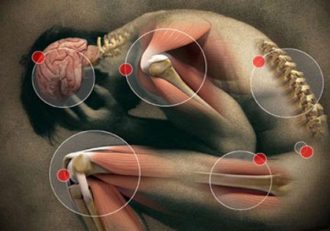Guest writer for Wake Up World
Almost everyone has experienced some type of muscle or joint discomfort in their life. The entire human body is covered with muscle tissue and joints that are in motion almost constantly, making it easy for discomfort to appear anywhere, anytime. The most common type of muscle discomfort is lower back pain. It is estimated that up to 80% of the adult population in the United States has lower back pain. It’s a top reason why people see a doctor. It is also a leading cause of disability in Americans under the age of 45.[1]
Muscle aches may involve ligaments, tendons, and fascia.[2] A ligament is fibrous tissue that connects bones to other bones. A tendon is a band of tissues that connects muscle to bone. Just like ligaments, they are made of collagen. Fascia is dense connective tissues that connect muscle, bones, and organs.[3]
Why Do Muscles Get Sore?
Sore muscles can result from a variety of reasons; exercise is the most common.[4] Other factors, such as stress can cause a stiff jaw, neck, or aches elsewhere on the body.[5] Twisting, bending, or straining can also cause problems.[1]
[pro_ad_display_adzone id=”110028″]
Certain medical conditions and diseases, such as fibromyalgia, infections, flu, Lyme disease, polio, and lupus, may cause muscle soreness.[2] Car accidents are a significant cause of injury, usually to neck muscles.[6] Almost 2.5 million people are injured or disabled in road crashes every year! Dehydration can cause electrolyte imbalances due to low levels of potassium, calcium, or magnesium and lead to muscle cramps and discomfort.
How to Relieve Sore Muscles and Joints
Chiropractic Sessions
Chiropractors are health care professionals who perform adjustments to the spine and other parts of the body.[7] The goal is to alleviate muscle and joint discomfort, improve function, range of motion, and support the ability of the body to heal itself.[8] There are currently more than 30,000 chiropractors treating approximately 30 million people per year in the U.S. These numbers will increase as people become more aware of the efficacy of chiropractic treatments.
Inversion Therapy
Inversion therapy involves hanging upside down from an inversion table for the purpose of taking pressure off the nerve and disks in your spine and increasing the space between the vertebrae.[9] A plethora of studies have confirmed the health benefits of inversion therapy.[10]
Practicing Yoga
Yoga is a mind and body practice that originated in India.[11] It involves practicing different physical postures, breathing techniques, meditation, and relaxation. According to the National Institute of Health, a weekly yoga class can be effective at reducing back discomfort.[12] It is no wonder why yoga is increasing in popularity; between 2012-2015, the number of American yoga practitioners grew by more than 75% from 20.4 million to over 36 million.
Stretching
As with yoga, stretching is incredibly effective for supporting muscle and joint health.[13]
Ice and Heat
When discomfort results from overuse or injury, applying ice for the first 24 to 72 hours is the first step toward relief. Following with heat can help soothe away the pain.[2]
What About Sprains and Strains?
A sprain is a stretched or torn ligament.[15] Remember, a ligament is a fibrous connective tissue that attaches bone to bone. According to the American Orthopaedic Foot and Ankle Society (AOFAS), as many as 25,000 people sprain an ankle every day. This adds up to almost 10 million sprained ankles every year![16]
Remedies for sprains and strains include rest, ice, compression, elevation, and physical therapy.[17]
How to Discourage Muscle and Joint Discomfort
Warming-up and stretching before and after exercise are extremely important. Sit and stand with good posture. Stretch a few times a week. Stay active. And, if you are overweight, losing weight can reduce the strain on your back.[18] Drink plenty of fluids before, during, and after exercise; and, if your work requires sitting in the same position most of the day, try to stretch or walk several times throughout the day (at least once every hour).[2] And, finally, maintain good form and posture when lifting heavy objects. Your legs should do most of the work.
What tips or insight do you have to offer? Leave a comment below and share your thoughts, or join the conversation on Facebook.
Article sources:
- 1 Steven Ehrlich. Low Back Pain. University of Maryland Medical Center. 2/14/16.
- 2 Linda Vorvick, David Zieve, Isla Ogilvie, A.D.A.M editorial team. Muscle Aches.Medline Plus. Updated 4/11/2015.
- 3 Schleip R, Klinger W, Lehman-Horn F. Active fascial contractility. Medical Hypotheses 2005;65(2):273-7.
- 4 Miles MP, Clarkson PM. Exercise-induced muscle pain, soreness, and cramps. Journal of sports medicine and physical fitness, 1994 Sep;34(3):203-16.
- 5 Linda J. Vorvick. Stress and Your Health. Medline Plus. 11/23/2014.
- 6 Back Injuries. Medline Plus.
- 7 Chiropractic. Medline Plus.
- 8 Chiropractic: In Depth. National Center for Complementary and Integrative Health. February 2012.
- 9 Edward Laskowski. Back Pain. Does inversion therapy relieve back pain? Mayo Clinic.
- 10 Inversion Therapy: a study of physiological effects. The Journal of the Canadian Chiropractic Association. 1985 Sep; 29(3): 135–140.
- 11 Yoga: In Depth. National Center for Complementary and Integrative Health. June 2013.
- 12 Nicki Contie. Yoga or Stretching Eases Low Back Pain. NIH Research Matters. October 31, 2011.
- 13 Karen Sherman, et al. A Randomized Trial Comparing Yoga, Streching, and a Self-care Book for Chronic Low Back Pain. Arch Intern Med. 2011 Dec 12;171(22):2019-2026.
- 14 Liliana L Jorge, Caroline C Feres, Vitor EP Teles. Topical preparations for pain relief: efficacy and patient adherence. J Pain Res: 2011; 4: 11–24.
- 15 Sprains and Strains. Medline Plus.
- 16 How to care for a strained ankle. American Orthopaedic Foot & Ankle Society.
- 17 Sprains and Strains. Medline Plus.
- 18 Prevent Back Pain. Healthfinder.gov.
Recommended articles by Dr. Edward Group:
- The Benefits of Apple Cider Vinegar
- Nutrition Facts Matter: What Food Labels Mean, and Why They’re Changing
- The 9 Best Fermented Foods for Your Gut
- 14 Foods that Cleanse the Liver
- Top 5 Foods for the Pineal Gland
- 6 Things You Must Know About Colloidal Silver
- The Importance of a Kidney Cleansing Diet
- The 9 Best Herbs for Lung Cleansing and Respiratory Support
- 7 Best Foods to Support Kidney Function
- Lung Cleansing With Peppermint Oil
- How Fluoride Damages Pineal Gland Health
- The Top 20 GMO Foods and Ingredients to Avoid – and Why
- How Does the Alkaline Diet Affect Gut Health?
About the Author:
 Dr. Edward F. Group III (DC, ND, DACBN, DCBCN, DABFM) founded Global Healing Center in 1998 and is currently the Chief Executive Officer. Heading up the research and development team, Dr. Group assumes a hands-on approach in producing new and advanced degenerative disease products and information.
Dr. Edward F. Group III (DC, ND, DACBN, DCBCN, DABFM) founded Global Healing Center in 1998 and is currently the Chief Executive Officer. Heading up the research and development team, Dr. Group assumes a hands-on approach in producing new and advanced degenerative disease products and information.
Dr. Group has studied natural healing methods for over 20 years and now teaches individuals and practitioners all around the world. He no longer sees patients but solely concentrates on spreading the word of health and wellness to the global community. Under his leadership, Global Healing Center, Inc. has earned recognition as one of the largest alternative, natural and organic health resources on the internet.
For more information, please visit Global Healing Center.
[pro_ad_display_adzone id=”110027″]







